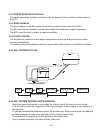
- 23 -
9-3 SUITING UP FOR STORAGE
Whether it’s the off-season or other circumstances prevent operating your engine-powered
equipment for more than 30 days, special steps need to be taken to protect the engine.
The first step in preparing an engine for storage is performing all of the suggested daily
maintenance items, such as cleaning the engine and checking the air filter. Next, run the engine
completely out of fuel or drain the fuel from the fuel tank . This is one of the most important steps
in preparing an engine for storage. Over time the volatile components of fuel evaporate and the
fuel becomes stale. Stale fuel makes starting the engine difficult, if not impossible, when the
machine is taken out of storage. Although it is usually suggested to drain the fuel, filling the tank
with new fuel and adding a fuel stabilizer is another option for preventing a stale situation.
To prevent corrosion in the cylinder bore during storage, remove the spark plug and inject a few
drops of oil through the spark plug hole. Gently pull the recoil starter knob two or three times
before the spark plug is placed back in the spark plug hole. Additionally, pull the recoil starter knob
until the resistance is felt, and leave it in that position. End the process with a final engine cleaning
before placing a protective cover over the unit and storing it in a dry place.
When returning the engine to service, ensure the oil viscosity is adequate for the temperatures
expected. Check the fuel lines and filter, making sure they are still secure and have not cracked.
Be sure that the throttle, choke and governor linkages move freely before starting the engine.
The initial start for an engine coming out of storage may be slow and there could be smoke for a
few minutes until any oil in the cylinder burns off. If the engine fails to start, check the spark plug
since it may have been fouled by the oil added to the cylinder before the machine was stored.
Clean or replace the spark plug before attempting to start the engine again.
Whether you’re preparing an engine for storage, adapting it to the weather or just keeping an eye
out for warning signs, giving an engine the attention it deserves will go a long way toward keeping
it out of trouble.


















